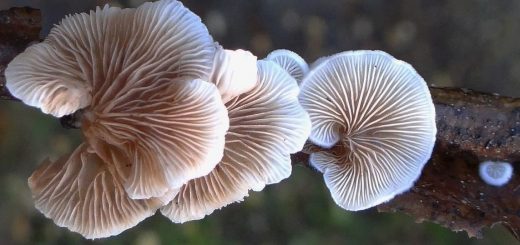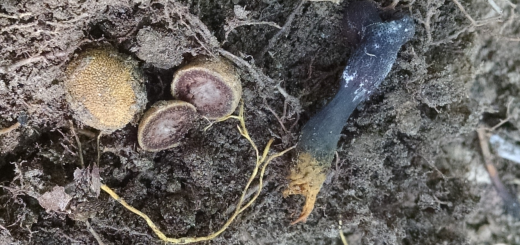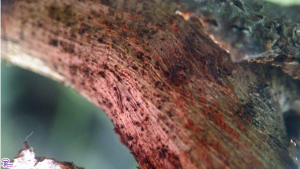#118: Poronidulus conchifer, the Little Nest Polypore
In its mature stage, this mushroom can be nearly impossible to differentiate from numerous other Turkey Tail-like polypores. Fortunately, young Poronidulus conchifer mushrooms produce unmistakable cup-like structures. This structure often looks like a cup fungus or a bird’s nest fungus without the eggs. For that reason, this mushroom is often called the “Little Nest Polypore.”
Unlike most other mushrooms, P. conchifer produces a structure specifically designed for releasing asexual spores. The mushrooms form in two stages, with the cup-like structure produced first. These “cups” form in clusters on the tops and sides of decomposing branches, logs, and other woody debris (particularly of elms) and are frequently encountered east of the Rocky Mountains. Each cup is only 5-20mm (0.2-0.8in) wide, so they are small but usually larger than bird’s nest fungi. The cups are generally circular, but are often slightly irregular. Most of them are cup- or vase-shaped with a short stalk, but some do not form a stalk and are flatter in the middle. The young upper surface of the cup is smooth and displays a distinctive bull’s-eye pattern with white, gray, and brown colors. These colors fade with age, so older specimens may look completely white. Underneath, the sides are smooth and white.
Since no pores are formed at this stage, it would be easy to mistake this mushroom for a cup fungus or a bird’s nest fungus. I am not aware of any cup fungi with concentric zones of color, so the bull’s-eye pattern easily separates P. conchifer from the cup fungi. If you can’t see the zones, you could also take a very thin pie slice out of the cup and examine it under a microscope. In the Little Nest Polypore, this would reveal a tangle of hyphae. In true cup fungi, this would reveal tightly-packed, cylindrical, spore-producing cells along the upper edge of the cup. Cups produced by the Little Nest Polypore differ from bird’s nest fungi because they are larger and never contain “eggs.” Even when bird’s nest fungi have discharged all their ovoid, spore-carrying structures, you can usually see a difference in color and texture between the sides of the cup and where the eggs used to be. Additionally, P. conchifer cups feel like polypores when you bend them. Many polypores have a tough, somewhat leathery texture that helps you identify them as a polypore even when they do weird things like make cups or form gills. True cup fungi tend to be rubbery and brittle, while bird’s nest fungi tend to be thinner and less sturdy.
Apparently P. conchifer forms this cup structure to help disperse asexual spores. Inside the cup, the Little Nest Polypore produces asexual spores called oidia. Oidia are spores produced through mitosis and are not the main type of spore produced by the fungus at that stage in its life cycle. Only a few oidia are produced at a time and they are borne on very simple hyphae (which makes sense, because the fungus is spending most of its resources on another type of spore production). Like the bird’s nest fungi, P. conchifer uses a splash cup mechanism to disperse its spores: the force of rain splashing in the cup launches the spores out into the air. This allows the oidia get out of the stagnant layer of air near the ground and into air currents that can carry them to new logs.
Of course, this is not the Little Nest Polypore’s main method of reproduction. It is simply a pause in mushroom development before sexual spore production begins in earnest. Having this pause allows the fungus to reproduce both asexually and sexually. Since the mushroom will develop further using the cup as a base, this is accomplished using very little extra energy.
After this pause, the cup starts growing pores on the smooth underside near the rim. The pores extend down and around the cup as well as out, with the upper edge of the new growth becoming a Turkey Tail-like pileus. At the end of this process, the cup may be fully engulfed by the new growth, thus making identification much more difficult. When fully formed, the mushrooms are 1-5cm (about 0.5-2in) across and roughly semicircular to kidney-shaped with the outer edges higher than the center. The pileus sports concentric zones of color (white to gray to brown) and is smooth except for wrinkles that radiate out from the center. On the underside of the pileus, the pores are whitish to yellowish, circular to angular (shaped like irregular polygons), somewhat roughened in profile, and small to medium-sized (2 to 4 pores per millimeter). The cup sometimes breaks up and pieces of it may become distributed as scales over the surface of the pileus.
To differentiate the Little Nest Polypore from T. versicolor, note the lack of hairs on the former’s pileus as well as its roughened pore surface. However, the best way to positively identify P. conchifer is to find its cup stage interspersed with its mushroom stage. The cups often appear next to mature mushrooms and you can usually find a trace of the cup stage at the base of at least one mushroom in a P. conchifer collection.
Because of its unusual morphology, P. conchifer has been placed in its own genus, Poronidulus. The genus name is apt, as it references its pore stage (Poro-) as well as its bird’s nest-like stage (-nidulus, which refers to the classic bird’s nest genus Nidula). The Little Nest Polypore is placed in the phylum Basidiomycota, class Agaricomycetes, order Polyporales, and family Polyporaceae. Unsurprisingly, this family contains the core polypores, including Trametes versicolor (the Turkey Tail).
See Further:
http://www.mushroomexpert.com/poronidulus_conchifer.html
http://www.messiah.edu/oakes/fungi_on_wood/poroid%20fungi/species%20pages/Trametes%20conchifer.htm
http://www.mushroomthejournal.com/greatlakesdata/Terms/oidiu163.html
http://www.howardbirds.org/fungi_book/pdf/Poronidulus_conchifer.pdf









![#011: Characteristics of Kingdom Fungi [Archived]](https://www.fungusfactfriday.com/wp-content/themes/hueman/assets/front/img/thumb-small-empty.png)

